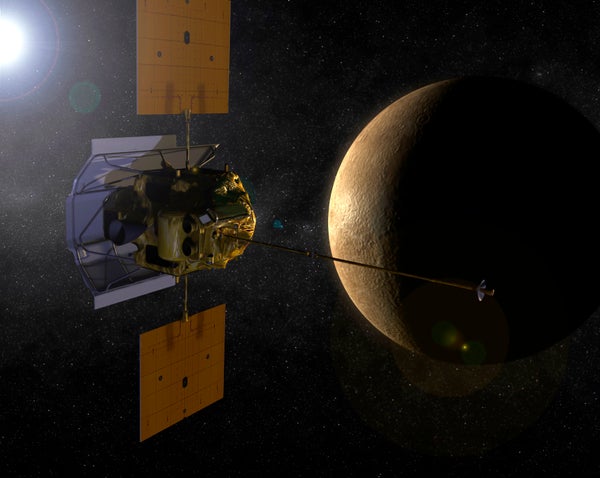Long gone are the days when physicists could validate new theories by dropping objects from the Leaning Tower of Pisa. From the discovery of the Higgs boson to the detection of gravitational waves, recent findings in physics have required a staggering level of precision. In search of this precision, scientists are increasingly turning to space as the ultimate laboratory.
The latest mystery that physicists hope to unravel beyond Earth is the neutron lifetime. Inside atomic nuclei, neutrons are stable. But when they travel freely, they decay into other particles within minutes. Pinning down the precise duration of neutrons’ life has been much tougher than expected. For decades experiments have given conflicting results. Knowing the true value would not just settle this long-standing debate. It would also help reveal the abundance of helium in the early universe and shed light on the formation of the first stars and galaxies.
Earth-bound neutron experiments have relied on two ways to measure the particles’ duration. The “bottle” method, which involves trapping neutrons in a container and counting how many remain as time passes, gives a lifetime of 879 seconds. Yet according to the “beam” method, in which experiments detect the protons created when neutrons decay, the latter particles live for 888 seconds. This nine-second difference is massive, compared with the calculated uncertainty in either measurement. So one of them must be wrong—but scientists do not know which.
On supporting science journalism
If you're enjoying this article, consider supporting our award-winning journalism by subscribing. By purchasing a subscription you are helping to ensure the future of impactful stories about the discoveries and ideas shaping our world today.
Enter MESSENGER, a NASA spacecraft launched to study Mercury in 2004. The probe carried a neutron spectrometer—an instrument that detected free neutrons escaping the planet to help map the minerals on its surface. Using the tool to measure a fundamental physical constant was never on MESSENGER’s agenda.
Enormous Bottle Trap
Recently, scientists realized that they might be able to reanalyze the mission’s data to measure the neutron lifetime. In a way, neutrons trapped by the gravity of a planet form an enormous bottle experiment—albeit one with a completely different set of systematic uncertainties than those associated with that method (or the beam approach) on Earth. Additionally, the space setting offers advantages such as a lack of noise from vibrations, says Nan Yu, who researches space-based precision measurements at NASA’s Jet Propulsion Laboratory.
A team led by Jack Wilson, a planetary scientist at the Johns Hopkins University Applied Physics Laboratory, first attempted to use data from MESSENGER’s 2008 flyby of Mercury. But the complicated surface composition of the planet created too much uncertainty in the calculations. Venus, on the other hand, hosts a well-understood atmosphere of carbon dioxide and nitrogen, so scientists knew how neutrons escaping from it would behave. The team turned its attention to MESSENGER’s 2007 flyby of Venus, which was made on the spacecraft’s way to Mercury—and produced a scant 45 minutes of data. “The only reason that the MESSENGER instruments were actually switched on during the Venus flyby was to check that they worked,” Wilson says. “It wasn't trying to do any science there.”
During the Venus flyby, the craft came within 340 kilometers of the planet, allowing the team to count the neutrons present at a wide range of altitudes. “Altitude is essentially a proxy for time,” Wilson explains. “The farther you are from the planet, the longer neutrons travel, the more likely they decay.”
Ultimately, he and his colleagues at Johns Hopkins and Durham University in England needed data from both flybys to complete their model. They calculated the neutron lifetime to be 780 seconds, plus or minus 90 seconds—a large uncertainty range consistent with both the beam and bottle methods. The results were published on June 11 in Physical Review Research. Though the measurement was not precise enough to break the measurement impasse yet, the method holds promise, scientists say.
Hope for a Resolution
“I think it’s a really neat idea. I was impressed that [the researchers] were able to do it,” says Shannon Hoogerheide, who runs ongoing beam experiments at the National Institute of Standards and Technology. Peter Geltenbort, who conducts bottleexperiments at the Laue-Langevin Institute in France, likewise welcomes the “amazing and exciting” result. Neither researcher was involved with the new study. Future measurements in space “could have a significant impact on the resolution of the neutron lifetime puzzle,” Geltenbort says. But he cautions that there is a long road ahead.
The fact that the MESSENGER calculations included data from flybys of both Mercury and Venus created a large systematic uncertainty. In a future mission, flying by Venus numerous times would eliminate the need for data from Mercury and dramatically decrease the uncertainty. Even so, Hoogerheide says, reducing the error bars from 90 seconds to less than nine seconds will be difficult. “The devil’s in the systematics,” she says. And given the cost and complexities of a mission to Venus, it will be years before particle physicists get the chance to collect new data.
In the meantime, Wilson’s team is analyzing old data from Lunar Prospector, a NASA probe that orbited the moon from 1998 to 1999. Like MESSENGER, the probe carried a neutron spectrometer that might yield an estimate of the particle’s lifetime. In this case, systematic uncertainties will arise from the small size of the moon and its lack of a thick atmosphere. Despite the challenges ahead, Wilson is optimistic. “I think having some radically different solution is exciting,” he says, “because it suggests that there’s real potential here to make significant progress.”
